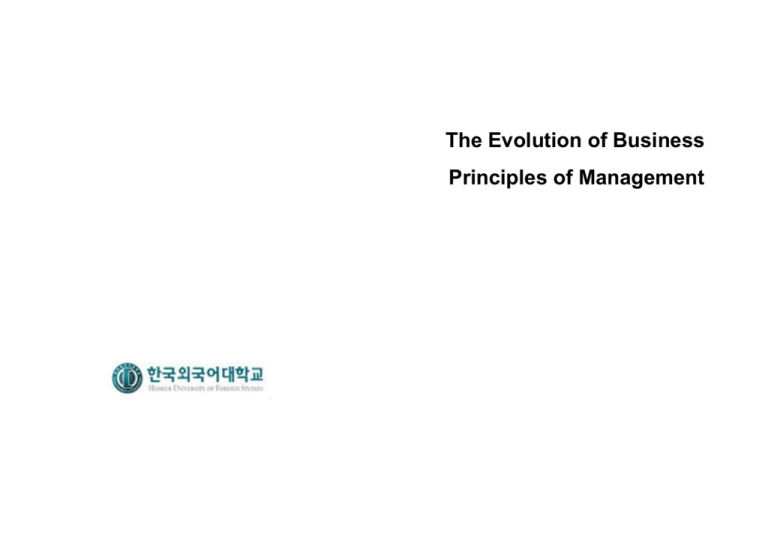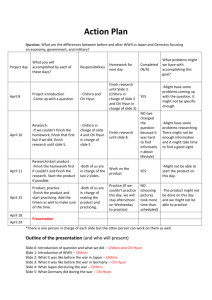The Evolution of Business Principles of Management
advertisement

The Evolution of Business Principles of Management Lesson 2 Chapter Objectives 1. Define the system of feudalism, and the issues in combining land and labor to speed the accumulation of capital. 2. Describe the system of mercantilism, and appreciate the role played by merchants, and bankers in speeding the development in global trade. 3. Explain the causes of the industrial revolution and the development of capitalism, unionism, and the class system. 4. Explain how and why the form of business organization used to manage business commerce has changed over time. © Jae Hoon Hyun 2 Lesson 2 Origin of Business • • • Business and its related activities began three to six thousand years ago Think of the division of labor needed to build the pyramids in Egypt Think of the food and water needed for a very valuable resource – labor © Jae Hoon Hyun 3 Lesson 2 Feudalism • Land and other resources were given by a king to the nobility and they in turn controlled the proletariats or peasants who worked the land for a hut and a subsistence wage © Jae Hoon Hyun 4 Lesson 2 Feudalism • The absence of motivation on the part of the peasants gave rise to tenant farmers sharing in more of the till and toil of the land © Jae Hoon Hyun 5 Lesson 2 Mercantilism • Merchants saw opportunities to trade at a profit • Mercantilism has evolved into Capitalism today, as private industrialists produce, trade, and distribute products • The use of money increases occupational specialization (similar to outsourcing of today) and the wealth that can be generated from labor and land © Jae Hoon Hyun 6 Lesson 2 Industrial Revolution • Increasing change and the growth of capitalism, led to technological progress and the most significant change in the business system © Jae Hoon Hyun 7 Lesson 2 Industrial Revolution • Increasing change and the growth of capitalism, led to technological progress and the most significant change in the business system • Change was pervasive in both farming and manufacturing as the use of technology could be used more efficiently than labor such as steam power or interchangeable parts to build sewing machines to manufacture clothing © Jae Hoon Hyun 8 Lesson 2 Capitalism • Private ownership of the means of production and distribution (property rights) • Its growth was not without its faults as some folks were ruthless and pursued their own self interest at the expense of others © Jae Hoon Hyun 9 Lesson 2 Capitalism •Capitalist factory owners exerted their economic power with greater demands upon labor • Declining wages and longer work hours created a proletariat working class and the workers reacted by forming trade unions •The Industrial Revolution and the rise of capitalism contributed to the creation of a class system based upon wealth and occupation as opposed to heredity as in aristocracy © Jae Hoon Hyun 10 Lesson 2 Business Commerce •As business commerce evolved so did the forms of business organizations used to increase the productivity and profitability of productive resources © Jae Hoon Hyun 11 Lesson 2 The Evolution of Company •The hierarchy of authority evolved early to reduce the transaction costs surrounding business activity •The joint stock company corporation evolved to make it easier for enterprising people to borrow capital to pursue new ventures and for wealthy people to find new ways in which they could build their capital and increase their wealth © Jae Hoon Hyun 12






